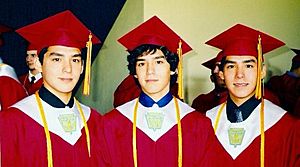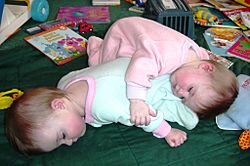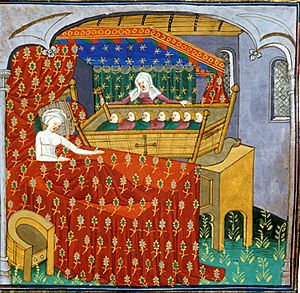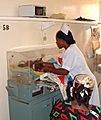Multiple birth facts for kids
Multiple birth is when one woman gives birth to more than one child at the same time. Depending on the number of children born, it can be called twins (two), triplets (three), quadruplets (four), and so on. There have been cases known in which woman gave birth to eight children at once. The chance of multiple birth grows when artificial insemination is used.
Contents
Terminology
Terms used for the number of offspring in a multiple birth:
- two offspring – twins
- three offspring – triplets
- four offspring – quadruplets
- five offspring – quintuplets
- six offspring – sextuplets
- seven offspring – septuplets
- eight offspring – octuplets
- nine offspring – nonuplets
- ten offspring – decuplets
Terms used for multiple births or the genetic relationships of their offspring:
- Monozygotic – multiple (typically two) fetuses produced by the splitting of a single zygote
- Polyzygotic – multiple fetuses produced by two or more zygotes:
-
- Dizygotic – multiple (typically two) fetuses produced by two zygotes
- Trizygotic – three or more fetuses produced by three zygotes
Multiple pregnancies are also classified by how the fetuses are surrounded by one or more placentas and amniotic sacs; the placentas are referenced as "chorions":
- Monochorionic fetuses share one placenta; dichorionic twins, trichorionic triplets, etc. each has a separate placenta.
- Monoamniotic fetuses share one amniotic sac; diamniotic twins each have their own sac, as do triamniotic triplets, etc.
- There are many combinations possible -- for example with dichorionic triamniotic triplets, one fetus has a separate placenta and two of the fetuses share a placenta, and each has its own amniotic sac.
Human multiple births
In humans, the average length of pregnancy (two weeks fewer than gestation) is 38 weeks with a single fetus. This average decreases for each additional fetus: to thirty-six weeks for twin births, thirty-two weeks for triplets, and thirty weeks for quadruplets. With the decreasing gestation time, the risks from immaturity at birth and subsequent viability increase with the size of the sibling group. Only as of the twentieth century have more than four all survived infancy.
Recent history has also seen increasing numbers of multiple births. In the United States, it has been estimated that by 2011, 36% of twin births and 78% of triplet and higher-order births resulted from conception by assisted reproductive technology.
Twins
Twins are by far the most common form of multiple births in humans.
Triplets
Identical triplets come from a monozygotic pregnancy, three fetuses from one egg.
Triplets are far less common than twins. Nevertheless, only 4 sets of identical triplets were reported in the U.S. during 2015, about one in a million.
Identical triplets or quadruplets are very rare and result when the original fertilized egg splits and then one of the resultant cells splits again (for triplets) or, even more rarely, a further split occurs (for quadruplets). The odds of having identical triplets is unclear. News articles and other non-scientific organizations give odds from one in 60,000 to one in 200 million pregnancies.
Quadruplets
Quadruplets are much rarer than twins or triplets. As of 2007, there were approximately 3500 sets recorded worldwide. There are around 70 sets of all-identical quadruplets worldwide. Many sets of quadruplets contain a mixture of identical and fraternal siblings, such as three identical and one fraternal, two identical and two fraternal, or two pairs of identicals. Quadruplets are sometimes referred to as "quads" in Britain.
Quintuplets
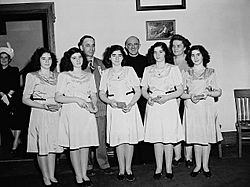
Quintuplets occur naturally in 1 in 55,000,000 births. The first quintuplets known to survive infancy were the all-female Canadian Dionne Quintuplets, born in 1934. Quintuplets are sometimes referred to as "quins" in the UK and "quints" in North America.
Sextuplets
Born in Liverpool, England on 18 November 1983, the Walton sextuplets were the world's first all-female surviving sextuplets, and the world's fourth known set of surviving sextuplets. Another well-known set of sextuplets is the Gosselin sextuplets, born May 10, 2004 in Hershey, Pennsylvania.
Very high-order multiple births
In 1997, the McCaughey septuplets were born in Carlisle, Iowa. Multiple births of as many as eight babies have been born alive, the first set on record to the Chukwu family in Texas in 1998; one died and seven survived. In 2009, a second set, the Suleman octuplets, were born in Bellflower, California. As of 2014, all were still alive shortly before their fifth birthday.
Cultural aspects
Certain cultures consider multiple births a portent of either good or evil.
Mayan culture saw twins as a blessing, and was fascinated by the idea of two bodies looking alike. The Mayans used to believe that twins were one soul that had fragmented.
In Ancient Rome, the legend of the twin brothers who founded the city (Romulus and Remus) made the birth of twin boys a blessing, while twin girls were seen as an unlucky burden, since both would have to be provided with an expensive dowry at about the same time.
In Greek mythology, fraternal twins Castor and Polydeuces, and Heracles and Iphicles, are sons of two different fathers. One of the twins (Polydeuces, Heracles) is the illegitimate son of the god Zeus; his brother is the son of their mother's mortal husband. A similar pair of twin sisters are Helen (of Troy) and Clytemnestra (who are also sisters of Castor and Polydeuces). The theme occurs in other mythologies as well, and is called superfecundation.
See also
 In Spanish: Nacimiento múltiple para niños
In Spanish: Nacimiento múltiple para niños
- Biological reproduction
- Conjoined twins
- Feodor Vassilyev
- Half a Dozen Babies, a 1999 drama film about the 1993-born Dilley sextuplets
- List of multiple births
- List of twins
- Only child
- Quints, a Disney Channel movie about a teenage girl becoming the older sister to quintuplets
- Three Identical Strangers
- Twin
Images for kids


